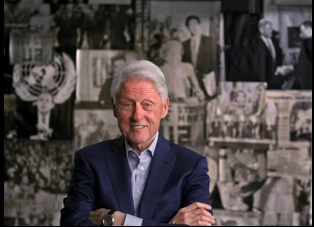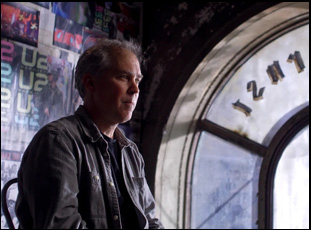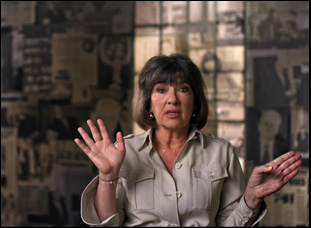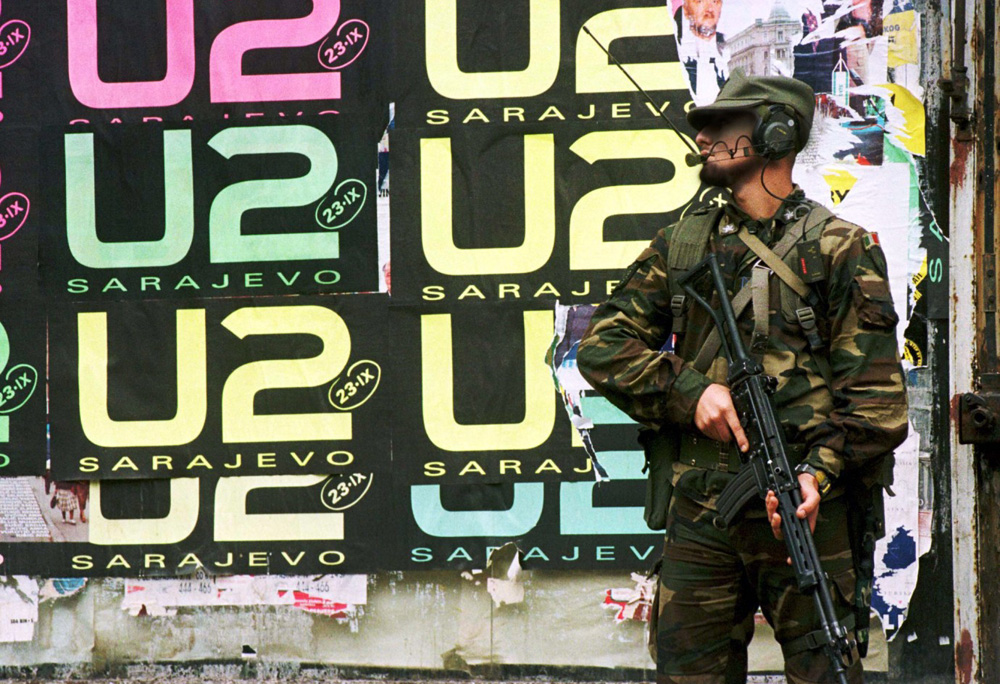When one hears about people huddling underground in Sarajevo during the brutal war waged on the heart of the Bosnian capital in the early 1990s, the image conjured is of them taking cover from the sniper fire above when Serbian nationalists had hoped to bring the newly independent country under their control. However, in “Kiss the Future,” Nenad Cican-Sain presents a different kind of refuge that local Sarajevans found, filing into the subterranean punk clubs that existed long before the war and would remain there after, letting their frustrations out in music. As the comedian Boris “Sibi” Siber puts it, “Art was my weapon,” meaning so in a variety of ways when he’d take the stage to offer entertainment to keep spirits high among local audiences and during the day, disrupt the communication of invading troops by infiltrating radio frequencies to blast Jimi Hendrix and the Clash.
Their stages would ultimately play host to the biggest rock act in the world in U2, but before that can happen in Cican-Sain’s new film, the director learns of the band that formed among Sarajevans to survive the four years of constant shelling and the international efforts to bring the violent invasion to an end. A bridge was built between those two in the most unexpected way possible when Bill Carter, an American who retreated to Bosnia after the death of his girlfriend, had the wild idea to reach out to U2 after hearing a clip of Bono on MTV sending his well wishes to the country with the hopes of bringing them to the wartorn region to bear witness to what was happening there.
“Kiss the Future,” which is based in part on Carter’s book of the same name, shows the extraordinary efforts to even put Carter in position to reach out to U2 when he had no connections to the music industry and the best form of communication was by fax, and while it would be a while before it was anywhere near safe enough for the band to even consider traveling to Sarajevo after making first contact, the film charts the relationship that unfolded once a brilliant compromise that was made during the ZOO TV tour, when with the help of satellites, the band would cede the stage to Sarajevans to share their experiences during their concerts when beaming in images from around the world on giant televisions was an organic part of the show.
Raising awareness around the world then about the dangerous threat of far-right nationalism in arenas around the world, “Kiss the Future” is poised now to turn movie theaters into such forums with the inspiring doc following its celebrated premiere last year at Berlinale and on the eve of the film’s release, Cican-Sain described a creative undertaking to make the film that seems every bit as improbable and incredible as luring U2 to Bosnia, parlaying his work on a narrative screenplay for Matt Damon and Ben Affleck’s production company Pearl Street Films into his first documentary feature and lining up interviewees such as former President Bill Clinton and Christiane Amanpour while recovering footage from the Siege of Sarajevo that had been hidden away in attics and basements for more than two decades.

A number of things happened. I was working with Pearl Street with Matt [Damon] and Drew [Vinton] developing a piece of material and I learned that Matt was friends with Bono through a beautiful story that he had shared with me, which led to a confluence of events [thinking about] the siege of Sarajevo and how people use art and music as a form of rebellion and survival. I’m from the region and I was there during the war, and being in the States [in the years since] and seeing how polarized the country was in 2017, then also the anniversary pop-up for the concert in Sarajevo in ’97 lit a fire inside of me. [I thought] how all these stories culminated into this concert would be a great way to tell a cautionary tale, but [also] a very inspiring story. Then I met Bill Carter and read his book [“Kiss the Future”] and thought, “This is great. We can use this for a part of the story as well,” and then Matt came on board [as a producer] after I had completed the other script because I didn’t want to ask him about another project until I delivered on the other one, and he went to Bono and then we got to work.
Was a documentary any different to crack than your narrative work? Or is storytelling storytelling?
Yeah, I think storytelling is storytelling, but you’re dealt a different set of cards. You have certain footage that exists that you use, but then you’ve got to shoot new footage, so it’s not like you write a script and go from scratch. We had an outline of a story that we wanted to do that Bill worked on as well and what happens — and sometimes this happens in a narrative feature as well — is you get a great interview or a great piece of footage, like the concert we found in the U2 Archives, and these golden goose eggs as you go along reshape the story.
One of the smartest decisions that I made during the making of this film was having my editor Eric Burton, who was an assistant editor on the last project that I worked on, come with me through the shooting of the movie and be there for every scene. I just believe this guy is extraordinary at what he does. And what we would do is we’d look at a piece of interview and then we knew we had some archive as we were shooting, so we were constantly rewriting and making the film as we were going along.

We knew that it needed to be a collective memory. and conceptually, before we even started to make the film, I knew that Alma, the local Sarajevan girl who was 13 years old in the film [during the war], had to be put on equal footing as the president of the United States. I also knew that the local punk band Siktar had to be on equal footing as U2. We weren’t going to do a buildup to, “Here’s the biggest band in the world, and then here’s this small punk rock band.” I knew that I wanted to go from the president of the United States talking about geopolitics instantaneously to a 13-year-old girl and the effects of that on the ground in Sarajevo at that time because you don’t usually see that.
Once we knew everybody was on equal footing and there was nobody who was given more or less attention to, that really helped us interweave these stories in a narrative way because in a documentary, you’ll [typically] have a five-minute buildup of the highlights of U2 in 1997, how big they were and the biggest band in the world, but we don’t do any of that. That freed us to be able to work in a narrative structure that you don’t typically get to work with, and also was what gave an editorial cadence in the way that the film was cut together.
There are so many moments in the film where you’ll have an amazing story and you have the footage to supplement it now, but I imagine you may not have known was out there when you were doing the interview. Was there anything you were particularly excited to find?
That was a never-ending process. There was the U2 archive, which nobody had seen before [of these particular concerts] and then there was the CNN and war archives from that period of time, because we had to tell Christiane Amanpour’s story as a reporter trying to shed light on this. And then Bill Carter’s archive came in, which was specific to the moments of when he was there in the story. Then as we started going along, there were two things that really lit me on fire and got me so excited [in terms of] how do you create the emotional core for this and what people are emotionally experiencing during the film. When Bill Carter introduced us to Vesna and Senad, who have a production services company in Sarajevo and were his friends during the war, I started talking to them [about] doing the research to help find the stories [of people living there at the time] and Vesna told me how she had gotten married. And I was like, wait, you got married during the siege where there was no food and water and you’re being shot at? And she said, “Yeah,” and I said, “Is there footage of that?” And she [said], “Yeah, we filmed it.” She was really apprehensive [about showing me] at first, but then I got the footage and I was just blown away. And I had that piece of music that plays over that section that I’ve been saving for years for the right cinematic moment.
The other was a shot of Enes [Zlatar Bure] from [the punk band] Sikter in the beginning of the film where he’s running down the street and he’s carrying two bags and it almost looks like [the tracking shot from] “Children of Men. It’s very cinematic and haunting with the red sky and I [asked him], “Where did this come from? Who shot this? This is very immersive and powerful.” So we did a bunch of research and we found the person who shot that was a Scandinavian cinematographer for two years and lived during the Siege of Sarajevo and shot this extraordinary footage. And then we found another Italian cinematographer who was doing the same thing in these beautiful, prosaic kind of shots. So at first people were very apprehensive to share more footage with us, but once they saw an assembly of the film and saw its intent, then we got their full archives and that footage is what gave the film that more immersive experiential feeling of what it is like to live under siege than having talking heads.

Again, I got lucky. One of my best friends is a production designer named Philip Messina, who did a lot of Soderbergh’s films and “Mother!” and “The Hunger Games,” and we didn’t really have a budget for a production designer, but the challenge was, how do you shoot people today and show archive of people back then, and have it not feel like two very alien worlds, being constantly pulled into the past and the present. I was really struggling with that and I started having a conversation with Phil, who was not on the movie at the time, but we were talking about these deteriorated buildings where we shot the interview of the Sarajevans. Sarajevo was the Red Cross building, which used to be a theater [before it] was bombed during the war and was full of bullet holes. So [I thought] let’s film in there, but how do we ground the audience into some of it? There’s a great scene in “Children of Men” [where] Clive Owen is being interrogated, sitting in a room with newspapers all around him and it was to disorient where he was and he was only immersed in that kind of world. That scene became an inspiration to Phil and I and Phil’s kept ideating off that.
We finally landed on surrounding people in these dilapidated buildings that used to be places where people would gather and use their individual archives and images to ground the audience in that world. There’s also an evolution in the film where it’s more black and white in the beginning and as the story emerges, there’s more color into those images and walls and we would be very kind of specific in how we design the walls at what stage of the film when we were shooting these interviews to know [when\ this one has either too much color or too little color to be able to make it all match. We couldn’t go from filming a rock star in his studio to a 13-year-old girl in a bombed out building, right? So how you meld those worlds was one of the biggest challenges in the design of the movie.
Something else that audiences can feel but may not notice exactly is that I understand your sound designer Samir Foko actually had this archive of sounds from Sarajevo since he lived there during the war.
That’s insane. Sarah Anthony led us to him and she was brought on as a line producer because she did “The Defiant Ones” and none of us had made a documentary before. I had this extraordinary working process with her and she ended up becoming a producer on the film in the process because of how good she was and she told me about Samir. A friend of hers had told her that there was this Bosnian sound designer who lived through the siege and was doing movies like “Harry Potter” and the David Bowie [doc] “Moonage Daydream.” We contacted him and not only did he live during the siege, but he was in one of the bands during the siege and was in Sarajevo in ’95 in when Bono snuck in under sniper fire, [a story] we didn’t put in the film because it would have been too much about Bono, but he went to a club on New Year’s Eve and he sang with a local band that Samir Foko was in. And Samir ended up becoming part of the War Child Conservatory after the war with Bono and Pavarotti and then became this incredible sound designer.
Through Sarah, I reached out to him and he told us his story and [how] he recorded the sounds of what life was like to live under siege and the sounds — [how] a shell really sounds [when] it doesn’t sound like that in a movie. So we ended up merging his sounds with that extraordinary footage that I was telling you about [from Vesna and Senad’s wedding] and then we brought in Ron Bartlett, who won the Academy Award for “Dune” and [we] said, “Let’s merge these images and sound to make it as experiential and immersive experience so people feel what it’s like to be under siege as opposed to being told what it’s like.
You really get that sense and I wonder what it was like for you to take the film back there since it premiered at the Sarajevo Film Fest after playing Berlin and Tribeca.
That was really intense. We screened for over 5,000 people — three venues the same night, in a massive open air theater. Actually, that [tracking] shot in the film that I was talking about from where [Enes from Sikter] is running with the bags and there’s that shelling going on in the early part of the film, he’s running past the Nachtman Theater [where] we screened. So it was very powerful and having the band there and people were very emotional. As a filmmaker, you’re in a bubble in the way you’re taken in and you go up and talk to the audience and you get taken away, but I remember as we were leaving, the streets were packed. You couldn’t move with so many people. People were so emotional. And I couldn’t believe that we had been able to enable them to have this experience from what they had lived through, and then we won the audience award, which was really moving for us as well. So it was really powerful. It was a once in a lifetime opportunity.
“Kiss the Future” opens on February 23rd in select AMC Theaters.




